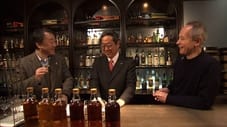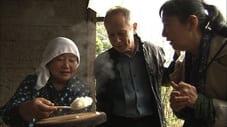
Japanology Plus (2014)
← Back to main
Ken Kumata — Executive Producer
Episodes 40
The English Conversation Business
Despite years spent studying the language at school, many Japanese feel inept at English. Perhaps that's why Japan's English conversation business rakes in hundreds of billions of yen each year. This time on Japanology Plus, we begin a two-part series focusing on English in Japan, and part one looks at English conversation classes. Our expert guest is Ruth Marie Jarman, a regular on an NHK English language education program. And in Plus One, a linguistic experiment on the streets of Tokyo!
Read MoreShrine & Temple Carpenters
Japan boasts many shrines and temples built using sophisticated techniques that have been passed down through the centuries. This time, we feature shrine and temple carpenters, the artisans behind many of Japan's best-known religious monuments. Our expert guest is Hideo Senda, the owner of a traditional carpentry firm that has been in business for 140 years. He will introduce us to some of the ancient techniques found in Toji, a temple in Kyoto. And in Plus One, carpentry with a difference.
Read MoreKids' Summer Holidays
Every year children in Japan eagerly look forward to their summer vacation, which generally runs from late July to late August. How do Japanese kids spend the hottest part of the year? Between homework, studying for entrance exams, playing video games, and going to summer camp, things can get rather busy! On this edition of Japanology Plus, our theme is kids' summer holidays. Our expert guest is biologist Takeshi Naganuma. And in Plus One, how children enjoy Japan's traditional summer festivals.
Read MoreHaunted Houses
It's Japan's timeless summer thrill...haunted houses! There are dozens of haunted-house attractions around Japan, many of them at theme parks. These creepy experiences are popular with people seeking to beat the scorching heat with spine-chilling fear, and they offer a distinctive style of fright. Our expert guest this time is Hirofumi Gomi, who has been the brains behind roughly 50 haunted houses in Japan. And in Plus One, eerie ghost art of centuries past.
Read MoreCameras
From compact point-and-shoot digital cameras to high-end SLRs, and those built into smartphones, cameras are a part of everyday life in Japan. Durability, affordability, and advanced features have earned Japanese-made cameras great popularity around the world. This time we explore Japan’s fascination with cameras. Our expert guest is Chotoku Tanaka, a professional photographer who also writes extensively about cameras and photography. And in Plus One, how to get a unique photo for posterity!
Read MoreTokyo Housing
From detached homes to tower blocks, from micro-houses on tiny lots to large dormitories, a vast variety of housing is jammed into Tokyo. Many homes feature ingenious use of space, including the traditional terraced houses called nagaya in Tokyo's old-fashioned neighborhoods. This time, we look at Tokyo housing. Our expert guest is Noriyoshi Suzuki, a researcher whose specialties include the history of residential architecture. And in Plus One, some of Tokyo's tiniest storefronts!
Read MoreMt. Takao
Mt. Takao, a peak that's visited by around 2.7 million people per year, is less than an hour by train from central Tokyo. This lushly wooded paradise has been regarded since ancient times as a place where sacred beings dwell, and our expert guest this time is Shujin Sato, a yamabushi, or mountain ascetic, who has been training on Mt. Takao for almost 3 decades. And in Plus One, the basics of hiking etiquette.
Read MoreWhisky
While Japan is halfway around the globe from the world's traditional whisky-making centers, in recent years premium Japanese whiskies have been winning top prizes in big competitions and winning fans in many countries. But these achievements are actually the culmination of decades of passionate efforts by dedicated professionals. Our expert guest this time is Mamoru Tsuchiya, editor-in-chief of a Japanese magazine devoted to whisky. And in Plus One, the perfect ice "sphere" for whisky on the rocks.
Read MoreBreakfast
In Japan, a traditional breakfast consists of steamed rice with miso soup and other side dishes. But these days noodles, pancakes, bread and granola are among the many other popular options for breakfast. This time on Japanology Plus, our topic is breakfast. We'll see what favorite foods, old and new, the Japanese eat to start the day. Our expert guest is Chieko Mukasa, a food journalist who traveled far and wide to write a book about Japanese breakfasts. And in Plus One, how to make great tamago-kake-gohan: raw egg mixed with steamed rice.
Read MoreRunning
Japan is a country of 10 million runners and some 2,000 open-entry running events, the most popular of which attract large crowds and live nationwide TV coverage. Japan loves not just the action but also the drama of an event such as ekiden, a unique form of long-distance relay with a century of tradition. This time our theme is running. Our expert guest, sports journalist Akemi Masuda, is herself a former Olympic marathon runner. And in Plus One, we experience the fun of a local running event.
Read MoreDriving Schools
In Japan, most people aiming to get a driver’s license go to a driving school. On closed courses complete with railway crossings and hills, driving schools helps students learn how to deal with every situation out on the road. Some offer on-site lodgings for intensive courses, whie others draw customers with nail salons. Our guest is journalist Yukihiro Yamada, an expert on transportation in Japan and author of a textbook used in driving schools. And in Plus One, learning how to ride a motorcycle.
Read MoreCapsule Toys
Capsule toys, also known as gachapon, are small toys purchased from vending machines. Though the cost of these toys is extremely reasonable, their fine attention to detail and handmade quality makes them anything but cheap. Join Peter Barakan and Matt Alt as they visit Japan’s foremost expert on capsule toys and discover why these tiny toys encapsulate the country’s attention to workmanship – and its playful side, too.
Read MoreThe Wonders of Air Travel
At Japan's busiest airports, a flight may arrive or depart every two minutes or so. In spite of this, Japanese airlines are frequently ranked among the world's leading on-time flight operators. Making their punctual performance possible are Japanese values and professional expertise. This time on Japanology Plus, we explore the wonders of air travel in Japan. Our expert guest, Shunji Akimoto, is a journalist who covers the air industry globally. And in Plus One, how to wash a passenger jet.
Read MoreOcean Fishing
Japan is an island nation that stretches thousands of miles. “A country surrounded by the sea,” as one common expression has it. Perhaps not surprisingly, the country has had a highly developed fishing culture for centuries, if not millennia. It has long been a global pioneer in everything from ways to preserve freshness to forms of seafood cuisine. This is our topic for this edition of Japanology Plus: how Japan fishes its oceans, in particular its coastal seas. Our expert guest is Professor Osamu Baba of the Tokyo University of Marine Science and Technology.
Read MoreShopping Streets
As in much of the industrialized world, a significant amount of shopping in Japan takes place in towering shopping malls and chain supermarkets. But cities and towns throughout the country are also home to a more traditional form of shopping thanks to their shotengai, or shopping streets.
Read More100 Yen Shops
Over the past year, 98% of people in Japan shopped at a 100 yen store. These shops were once associated with cheap, low-quality merchandise. Over the years, however, quality has been improving, and now 100 yen goods are often used in everyday life. Exactly how do 100 yen shops contribute to general well-being in Japan? This time on Japanology Plus, our expert guest is Emiko Masao, who writes an influential blog about making the most of what 100 yen shops offer. And in Plus One, ways to use 100 yen items in a DIY project.
Read MoreGraves
The way a society deals with death, and how it pays tribute to those who have passed away, will tend to reveal a great deal about that society's values. That's as true of Japan as anywhere else in world—and like other regions and countries, Japan has a long history of grave-making, together with thousands of years of rituals and practices. These days, as Japanese attitudes toward family life, financial matters, and more evolve, so too are attitudes toward graves. On this edition of Japanology Plus, we explore the past, present and future of graves.
Read MoreThe Ogasawara Islands: A Multicultural Heritage
This time on Japanology Plus, our theme is the Ogasawara Islands, a remote archipelago with a unique ecosystem and multicultural heritage. Located 1,000 kilometers off Japan's Pacific coast, the Ogasawara Islands were first settled by a group of Westerners and South Pacific Islanders, who interacted with later Japanese settlers to bring forth a unique culture. Our expert guide is Sho Sebori, a direct descendant of the American who became the leader of the first community on the islands.
Read MoreUnderground Shopping Streets
Japan is a world leader in utilizing underground space, and that's exemplified by its network of underground shopping streets. There are around 80 of these subterranean shopping centers across the country, selling the goods and services that Japanese people need in their daily lives. This time on Japanology Plus, our theme is underground shopping streets. Our guest is Yu Hiroi, an expert on urban disaster mitigation. And in Plus One, we visit Japan's oldest surviving underground shopping street.
Read MoreSchool Satchels
Almost every primary school student in Japan uses the same type of school bag. These distinctive, blocky satchels are spacious, durable, and packed with clever features. This time on Japanology Plus, our theme is school satchels. We explore their history, production, and future potential. Our guest is Kuniyo Hayashi, the president of a long-established satchel-making company. And in Plus One, a primary school student shows us how she uses her bag on a day-to-day basis.
Read More












